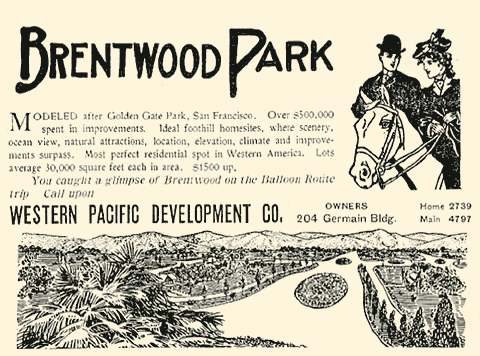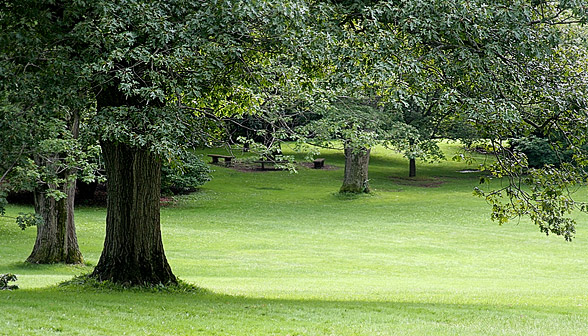|
"Explore Neighborhoods Within Neighborhoods"
| |
The Neighborhood Of Brentwood ParkThe area between Sunset and San Vicente west of Kenter/Bundy is referred to as Brentwood Park. Its boundaries are between Cliffwood Avenue (north and south of Sunset Blvd. (on the east), to Rockingham Avenue, north and south of Sunset Blvd. (on the west). The Park is a desirable community to dwell in because it is perceived as a wooded refuge, a place to get away from the bustling city. This unique style of living has been preserved by the Brentwood Park Property Owners' Association that was founded in 1915. HistoryAn ad in the Los Angeles Times on April 19, 1907 describing the recently developed community began like this, "To live in Brentwood Park means to have the conveniences of city life brought to the doors of your country estate .... Mail and fresh eggs are brought to your home twice each day. Garbage is removed three times a week. Streetlights twinkle at night. There is a kindergarten in the Park and an autobus takes children to and from grammar school and Sunday school."
Governor Juan B. Alvarado had given a grant (over 30,000 acres of land) to the Sepulveda family in 1839. The Sepulveda heirs sold their holdings 33 years later for less than 2 dollars an acre. After the transaction the property changed hands many times. Finally, the property that came to be known as Brentwood Park was purchased by the Western Pacific Development Company who then developed the subdivision in 1906. This residential community was one of the first subdivisions to be established on San Vicente Boulevard. The developers were insistent on creating a woodsy atmosphere; they had guidelines to ensure a pastoral and natural setting. Unlike city streets, cement sidewalks and curbs were avoided altogether and the wide streets were windy due to the natural contours of the land. At the time of Brentwood Park's development, modes of transportation were still works in progress. The Los Angeles-Pacific Railroad built the Westgate Line of Red Car service in 1906. This electric trolley transported people from San Vicente Boulevard to Ocean Avenue and then south to the Santa Monica Main Line. The convenience of the trolley appealed to people tremendously; in effect, lot sales throughout the area boomed. The Western Pacific developers developed many restrictions as a way to maintain the Park as a quality neighborhood. Those restrictions are still in effect today, they include the prohibition of the distillation and sale of alcohol; the development of more than one residence per lot; the posting of billboards and the erection of oil wells; and businesses of any kind. Restrictions regarding race, color and creed, were ruled unenforceable by the U.S. Supreme Court in 1948. Some of the specific regulations were as follows: Most lots had a minimum frontage requirement of one hundred feet and it was required that the houses be set back fifty to one hundred feet from the property line. All houses were to be placed no less than fifteen feet from the side property line and for corner lots, the minimum was twenty-five feet from the side street. Because of these restrictions, the Park has been saved over the years from being downsized into smaller parcels. Soon after its ideal start, Brentwood Park faced many threats. Western Pacific faced a financial panic in 1907 which caused them to stop its development process. In 1909, the company sold a large amount of its stock to Dr. Herman Janss who was of the Braly-Janss Company. The next major event happened in 1916 when the residents of Brentwood Park voted to be annexed by the City of Los Angeles in order to obtain municipal services. The city had many conditions for annexation, but one in particular was that it take charge of the streets, ovals, and circles. Ten years later when Los Angeles had installed storm drains and sewers and paved and curbed the streets, it exercised its rights as "steward of the islands" and removed all but eight of the existing ones (leaving four ovals and four circles.) In removing the islands, it straightened the curving roadways leaving most of Brentwood Park's roadways straight. Until 1989, seven traffic islands remained when an eighth one was added. Cleminshaw Circle, at the junction of Rockingham, Avondale and Marlboro, was planned and built through a cooperative effort of the city, the Brentwood Park Property Owners' Association and generous neighbors. Only one-fourth of the property in Brentwood Park had been purchased at the time of annexation in 1916. It wasn't until 1922 when Shipley, Harrell, and Trapp bought the remaining property and set out on a huge sales campaign. Initially, sales multiplied but soon died down. The men decided to offer half lots (fifty feet wide) which were against the regulations. One of the property owners sued the business men for failing to adhere to the frontage requirements and he won.
From the beginning, Brentwood Park was seen as a refuge from the hectic life in the city. The preservation of this park-like residential neighborhood will undoubtedly stand the test of time, seeing as it already has endured so much. Preview all properties for lease below: Preview all properties for sale here: |


